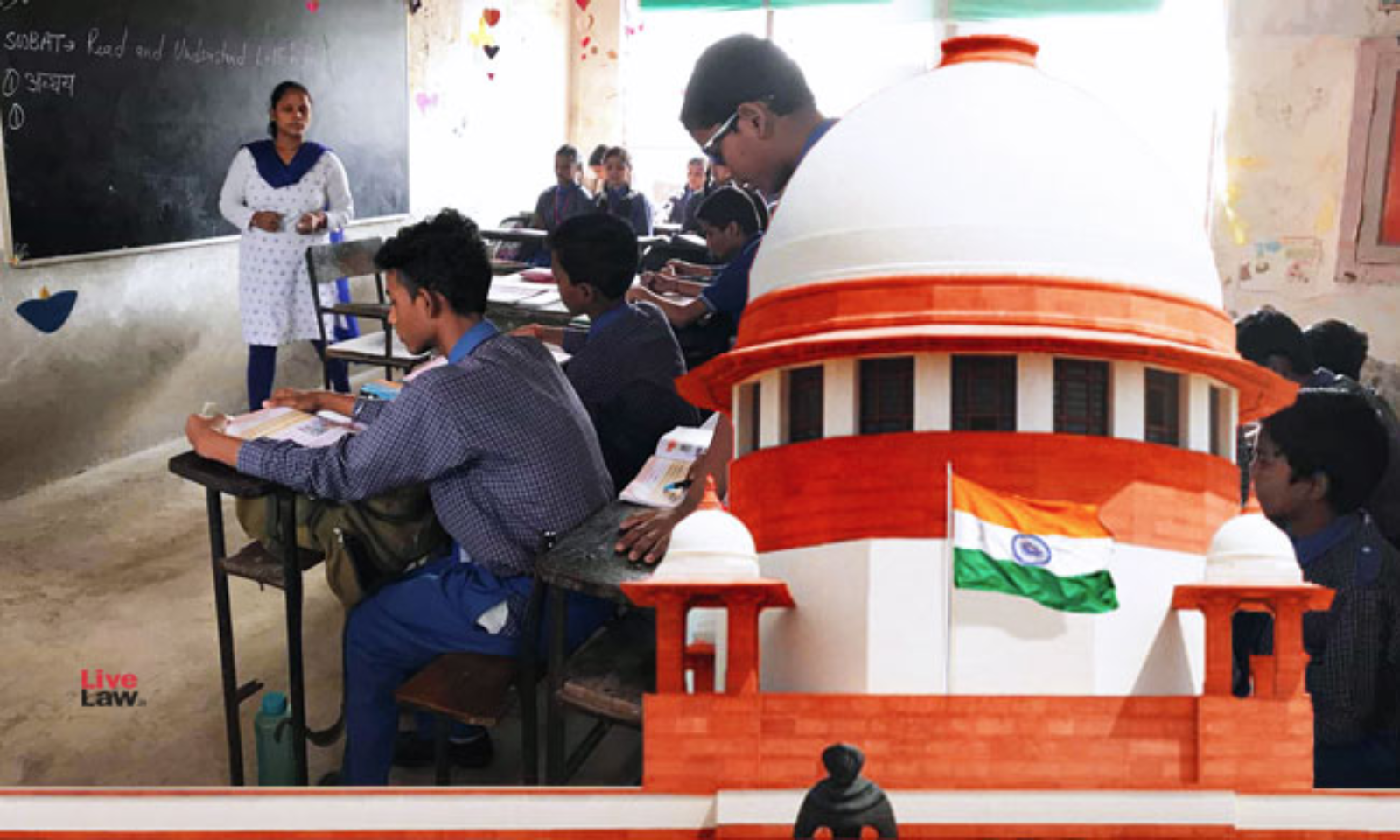 |
| copyright @ livelaw |
This article is written by RUZELA DA CRUZ, a law student of V. M. Salgaocar College of Law,Goa
INTRODUCTION
Education is a very powerful tool that can shape the destiny of an individual as well as the whole nation. It is an important mechanism for the advancement of human beings and has a positive effect on them as it emancipates them and leads them to liberation from ignorance. Education is an instrument of social change. It also enables a person to become a better and responsible member of society as it makes him/her aware of their rights and duties. Hence the significance of education for every single person is unquestionable.
EDUCATION AND THE INDIAN CONSTITUTION
Initially, the constitutional framers had incorporated certain provisions regarding education in Part IV of the Indian Constitution which contains the Directive Principles of State Policy. Article 41 says that subject to the limits of its economic capacity and development, the State must make provisions for securing the right to education. Article 45 directed the State to make provision for free and compulsory education for all children up to 14 years of age within 10 years of the commencement of the Constitution. Article 45 has now been amended and it provides for early childhood care and education. Article 46 says that the State must promote the educational and economic interests of the weaker sections of the people, with special care.
However, the Directive Principles of State Policy are not justiciable and cannot be enforced in the court of law. They are merely directives or ideals which the State must keep in mind while formulating policies and enacting laws. Hence the right to education had not been accorded the position of a fundamental right as it had not been expressly mentioned as a fundamental right in Part III of the Indian Constitution.
RAMAMURTI REVIEW COMMITTEE
A Review Committee chaired by Acharya Ramamurti was appointed in 1990 to evaluate and review the implementation of the National Policy of Education 1986. Many important recommendations were made by this Committee. One such major recommendation that it made was that the right to education should be examined for inclusion among the fundamental rights. However, the State did not take any concrete steps in this regard.
ROLE OF THE JUDICIARY
The judiciary played a very crucial and major role in making the right to education a fundamental right. Various judicial pronouncements have led to the right to education becoming a fundamental right. Some of these important judicial decisions are as follows:
In the case of Anand Vardhan Chandel v University of Delhi & Ors.[1] the petitioner contended that his fundamental right to education had been denied to him as he was not allowed to contest the elections of the Delhi University Students Union. He argued that participating in the activities of the Students Union was a part of the right to education. The Delhi High Court held that the right to education was included in Article 21 of the Constitution and the Petitioner had been deprived of this right. In this case, the right to education was for the first time recognised as a fundamental right under Article 21 of the Constitution which deals with the Right to Life and Personal Liberty.
In the case of Bapuji Educational Association v State[2], the petitioners challenged the constitutional validity of the Karnataka Educational Institutions (Prohibition of Capitation Fee) Act 1984. The Karnataka High Court held that the impugned Act was valid and said that the right of an individual to have and/or to impart education is one of the most sacred and valuable rights that is included in Article 21. Both the above-mentioned cases were decided by High Courts and so were not nationally binding precedents.
The decision of the Supreme Court in the case of Mohini Jain v State of Karnataka[3] marked a watershed moment in the journey of the Right to Education becoming a justiciable fundamental right. In this case, the petitioner Mohini Jain challenged the constitutionality of imposing capitation fees on candidates who wanted admissions in private medical colleges but were not admitted to the government seats.
The petitioner contended that a fundamental right to education was conferred by the Constitution and the imposition of capitation fees was arbitrary, unfair and unjust. The Supreme Court held that there is a right to education under the Constitution and this right directly flows from the right to live with dignity guaranteed under Article 21. The imposition of capitation fees was held to be unconstitutional.
Further, in the case of Unni Krishnan v State of Andhra Pradesh[4], the constitutionality of capitation fees was challenged again. The issue, in this case, was regarding the extent to which the right to education under Article 21 would apply. The contention of the petitioner was that since the right to education applies to primary education, the same should also be made applicable to professional education. The constitutional bench of the Supreme Court re-examined the judgment of Mohini Jain. The Supreme Court in Unni Krishnan’s case held that the right to education is implicit within the fundamental right of life and personal liberty guaranteed under Article 21 of the Constitution. However, the Supreme Court also said that the right to education guaranteed under Article 21 is not absolute, as a citizen has the right to get free education only till he completes 14 years of age. Beyond the age of 14, the right to education of a citizen is subject to the limits of the economic capacity and development of the State as envisaged in Articles 41 and 45 of the Indian Constitution.
In a Public Interest Litigation titled Bandua Mukti Morcha v Union of India[5], the Supreme Court was petitioned to issue directions to the State of Uttar Pradesh to take appropriate steps and measures to end child labor that was very rampant in Uttar Pradesh particularly in the carpet industry. The Supreme Court directed the State of Uttar Pradesh to end the use of child labour in the carpet industries and to also ensure that all children below 14 years of age who are employed in factories, mining, etc are provided with compulsory education. The court observed that the Right to Education is implicit in and flows from Article 21 and that by practicing child labour, children were being deprived of their meaningful right to life enshrined in Article 21 which includes access to food, medical aid, shelter, and also education.
86th CONSTITUTIONAL AMENDMENT ACT AND ARTICLE 21-A
The 86th Constitutional Amendment Act 2002 inserted Article 21-A in the constitution which expressly made the right to education a fundamental right. Article 21-A says that the State must provide free and compulsory education to all children within the age group of 6 to 14 years, in a manner which the State may, by law, determine. Article 45 was also amended and it now states that the State shall provide for early childhood care and education to children who are below the age of 6 years.
To ensure that Article 21-A is implemented in a better and effective manner, the Right of Children to Free and Compulsory Education Act 2009 was enacted. This Act makes it obligatory for the Government to provide all children within 6 to 14 years of age with free and compulsory elementary education.
In the case of Society for Unaided Private Schools of Rajasthan v Union of India & Anr[6], the constitutional validity of the Right of Children to Free and Compulsory Education Act 2009 was challenged. The Supreme Court upheld the validity of the impugned Act which was enacted to protect and give effect to the fundamental right to education which every child was entitled to under Articles 21 and 21-A of the Constitution.
Further, in the case of Avinash Mehrotra v Union of India[7], the Supreme Court held that the right to education enshrined in Articles 21 and 21-A included the right to receive education in a safe environment and free from the fear of safety and security. This was a writ petition filed following a tragic incident in a school in Tamil Nadu, wherein 93 students were killed and many others injured due to a fire that spread in the school.
Hence over the years, the judiciary has been very vocal and proactive while dealing with the right to education through its various decisions.
CONCLUSION
The judiciary is a custodian and guardian of the Constitution and it protects the rights of people. The judiciary has played a very vital role in making the right to education a fundamental right. Various judicial pronouncements, over the years, have ensured that education in India is given the importance it deserves. From declaring the Right to Education as a fundamental right to upholding the constitutional validity of the RTE Act 2009 and to also enforcing and protecting this right in various circumstances, the judiciary has always been at the forefront.
REFERENCE :
[1] AIR 1978 Del 308
[2] ILR 1985 Kar 80
[3] AIR 1992 SC 1858
[4] 1993 SCC (1) 645
[5] (1997) 10 SCC 549
[6] (2012) 6 SCC 1
[7] (2009) 6 SCC 398





0 Comments